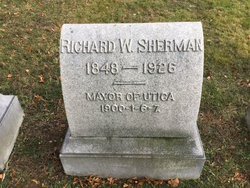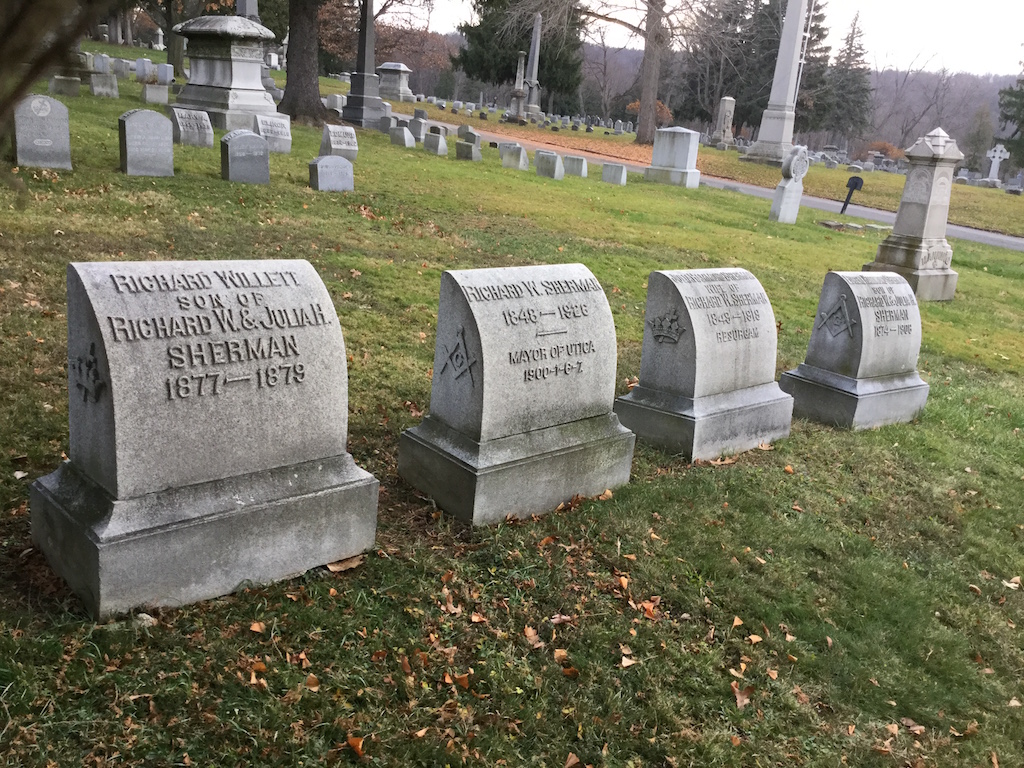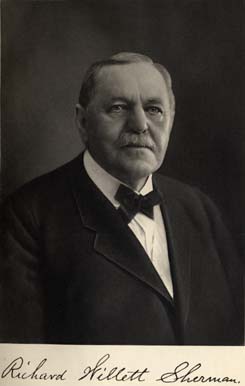The son of a distinguished sire, Hon. Richard Willett Sherman has worthily followed in his footsteps and Utica numbers him among its foremost citizens. He long occupied a position of leadership in engineering circles of the state and was equally successful as a contractor, in which connection he erected many important public utilities throughout the east, thus becoming a power in constructive development and evolution. He was also a conspicuous figure in civic affairs, rendering valuable service to the municipality in the capacity of mayor, and is now living retired at the ripe age of seventy-six years, having well earned a period of leisure.
Richard Willett Sherman was born in Utica, December 4, 1848, and is the eldest son of General Richard U. Sherman, who was numbered among the illustrious men of the Empire state. A complete record of the family appears elsewhere in this work. Richard W. Sherman attended the public schools of his native city in 1855 and 1857 and in 1858 removed with the family to the farm near New Hartford in 1858, becoming a pupil in the district school of that locality, while during two winters he was a student in the Bryant & Stratton Business College at Utica. In 1864 and 1865, during his father's absence in Washington as assistant clerk in the house of representatives, he took full charge of the farm. The next year he found employment in his future profession, becoming rodman in the engineers' corps of the Utica, Chenango & Susquehanna Valley Railroad, now the Delaware, Lackawanna & Western Railroad, which was then being constructed between Utica and Sherburne. In the spring of 1867 he secured a similar position on the Albany & Susquehanna Railroad, now the Delaware & Hudson, working on the line between Bainbridge and Binghamton. In the spring of 1868 Hon. DeWitt C. Littlejohn, at that time president of the New York & Oswego Midland Railroad, now the Ontario & Western, gave Mr. Sherman a position as assistant engineer, with charge of the construction of the roads between Oneida and Central Square, and upon the completion of this task Mr. Sherman was made resident engineer for the same company to construct that part of the line between Walton and East Branch, including the Hawks Mountain tunnel. Upon the completion of the Midland system in 1873 Mr. Sherman had charge of the second track work on the Delaware division of the Erie Railroad between Port Jervis and Hancock.
In 1875 Mr. Sherman entered the contracting field, forming an association with Messrs. Sullivan and Shanley of the New York and Canada Railroad. The next year, in partnership with Dr. Emmett Flagler, he constructed the West Troy and Green Island waterworks and later the firm of Sherman & Flagler built the waterworks at Gloversville, Richfield Springs and Walton. They also engaged in the construction of public projects in Vermont and Ohio, likewise made improvements on the Champlain and Erie canals and also executed other important contracts. The firm of Sherman & Flagler was dissolved in 1879 and Mr. Sherman then went to Havana, Cuba, to superintend for New York contractors the construction of a gas plant supplying by one system the entire city of Havana. Returning from Cuba in 1880, he executed a contract to provide Greenwich, Connecticut, with water works. In 1881 he formed a partnership with Michael McDonough, who became the junior member of the firm, and they filled many large contracts, constructing the waterworks at Lansingburg, Sandy Hill, Little Falls, Camden, Canastota, New Berlin and several other places.
In 1886 Thomas F. Kinney, the mayor of Utica, appointed Mr. Sherman to the office of city surveyor, which he filled until the close of the year 1888 and also in 1894. During that period many improvements were planned and effected, placing Utica in the front rank of beautiful cities, and during his tenure of office the public works of the city were improved. The system inaugurated is universally recognized as a monument to the enterprising spirit of Mayor Kinney and the engineering genius of Mr. Sherman. In 1888 the business of Sherman & McDonough was incorporated under the name of Troy Public Works Company, of which Mr. Sherman was president, and exceptionally successful work was done by the company, which constructed a large part of the waterworks of Utica, and in many other places in the state. Under contracts with the United States government the company also built the foundation for the gun factory at Watervliet.
Meanwhile a most important and interesting passage in the story of Mr. Sherman's career takes us back to Utica, to which special circumstances called him in 1899. Five years before, Mayor John G. Gibson had appointed Mr. Sherman to his old office of city surveyor, which he held until his assistant, C. L. Johnson, could prepare to succeed him, when he tendered his resignation. In the fall of 1899 Mr. Sherman became the democratic candidate for mayor, winning the election by a majority of eighty-seven. The pledges upon which he won the victory over his opponent were the enforcement of public contracts and of labor laws; to meet public demand for clean streets; to maintain law and order and to give the city a government at once strong, honest and worthy of universal respect. In all these particulars Mr. Sherman's administration of 1900 and 1901 was recognized as a complete success. The bold venture of proceedings for the removal from office of police and fire commissioners upon charges made by the mayor were successful in spite of a bitter contest in the courts in restraint of the action. The accused officials were brought to trial and were removed. Upon the completion of his term Mr. Sherman declined to run again, but such had been the appeal to the citizens of his work that the democratic successor carried the election by about nine hundred majority. The republican machine, which was strong enough in the common council to override the mayor's veto, Mayor Sherman fought with unflinching courage and at least discredited its corruption with honest vetoes. Some of the more notable of his veto messages even the corrupt majority did not dare to disregard. It was under the Sherman administration in Utica that monumental improvements were provided for, including the new public library building and new school buildings, for which large sums were voted by the people. At the same time plans were carried through with the New York Central Railroad for a new passenger station and a new freight house, and in connection therewith a project of river straightening, and the abolition of grade crossings on principal streets.
In the state election of November, 1902, Mr. Sherman was the candidate of his party for state engineer and surveyor against the incumbent of the position, a republican candidate, Edward A. Bond. He was the only democrat on the state ticket to carry Oneida county, which he did by a plurality of seventy-six, and his vote in the state was six hundred and fifty-one thousand, six hundred and seventy-seven against six hundred and sixty-three thousand, six hundred and seventy-four for Mr. Bond. Mr. Sherman filled the important position of chief engineer of the New York State Conservation Commission from August, 1911, until April, 1915. He is a member of the American Society of Civil Engineers and broad experience enables him to speak with authority on questions relating to engineering projects, on which his advice is frequently sought and highly valued.
In early manhood Mr. Sherman was married to Miss Julia Hammond, a daughter of Erwin A. Hammond of Utica. Mr. and Mrs. Sherman became the parents of three children; Eugene H.; Richard W., who died in infancy; and Elizabeth H., who is a successful educator and has long been a teacher in the kindergarten department of the public schools of Albany, New York. Eugene H., the first named, graduated from Yale University and from the New York Law School. He engaged in the practice of law for some time and departed this life in December, 1906.
In religious faith Mr. Sherman is a Presbyterian. He takes an interest in philanthropic work and is also a worthy exemplar of the Masonic order, belonging to Utica Lodge, No. 47, F. & A. M. He is a member of the Oneida Historical Society and the Albany Country Club. His life has been long, honorable and useful, crowned with notable achievement, and in contemplating his career it is worthy of remark that great cities are built, institutions are founded and national progress furthered by men of this type.
The son of a distinguished sire, Hon. Richard Willett Sherman has worthily followed in his footsteps and Utica numbers him among its foremost citizens. He long occupied a position of leadership in engineering circles of the state and was equally successful as a contractor, in which connection he erected many important public utilities throughout the east, thus becoming a power in constructive development and evolution. He was also a conspicuous figure in civic affairs, rendering valuable service to the municipality in the capacity of mayor, and is now living retired at the ripe age of seventy-six years, having well earned a period of leisure.
Richard Willett Sherman was born in Utica, December 4, 1848, and is the eldest son of General Richard U. Sherman, who was numbered among the illustrious men of the Empire state. A complete record of the family appears elsewhere in this work. Richard W. Sherman attended the public schools of his native city in 1855 and 1857 and in 1858 removed with the family to the farm near New Hartford in 1858, becoming a pupil in the district school of that locality, while during two winters he was a student in the Bryant & Stratton Business College at Utica. In 1864 and 1865, during his father's absence in Washington as assistant clerk in the house of representatives, he took full charge of the farm. The next year he found employment in his future profession, becoming rodman in the engineers' corps of the Utica, Chenango & Susquehanna Valley Railroad, now the Delaware, Lackawanna & Western Railroad, which was then being constructed between Utica and Sherburne. In the spring of 1867 he secured a similar position on the Albany & Susquehanna Railroad, now the Delaware & Hudson, working on the line between Bainbridge and Binghamton. In the spring of 1868 Hon. DeWitt C. Littlejohn, at that time president of the New York & Oswego Midland Railroad, now the Ontario & Western, gave Mr. Sherman a position as assistant engineer, with charge of the construction of the roads between Oneida and Central Square, and upon the completion of this task Mr. Sherman was made resident engineer for the same company to construct that part of the line between Walton and East Branch, including the Hawks Mountain tunnel. Upon the completion of the Midland system in 1873 Mr. Sherman had charge of the second track work on the Delaware division of the Erie Railroad between Port Jervis and Hancock.
In 1875 Mr. Sherman entered the contracting field, forming an association with Messrs. Sullivan and Shanley of the New York and Canada Railroad. The next year, in partnership with Dr. Emmett Flagler, he constructed the West Troy and Green Island waterworks and later the firm of Sherman & Flagler built the waterworks at Gloversville, Richfield Springs and Walton. They also engaged in the construction of public projects in Vermont and Ohio, likewise made improvements on the Champlain and Erie canals and also executed other important contracts. The firm of Sherman & Flagler was dissolved in 1879 and Mr. Sherman then went to Havana, Cuba, to superintend for New York contractors the construction of a gas plant supplying by one system the entire city of Havana. Returning from Cuba in 1880, he executed a contract to provide Greenwich, Connecticut, with water works. In 1881 he formed a partnership with Michael McDonough, who became the junior member of the firm, and they filled many large contracts, constructing the waterworks at Lansingburg, Sandy Hill, Little Falls, Camden, Canastota, New Berlin and several other places.
In 1886 Thomas F. Kinney, the mayor of Utica, appointed Mr. Sherman to the office of city surveyor, which he filled until the close of the year 1888 and also in 1894. During that period many improvements were planned and effected, placing Utica in the front rank of beautiful cities, and during his tenure of office the public works of the city were improved. The system inaugurated is universally recognized as a monument to the enterprising spirit of Mayor Kinney and the engineering genius of Mr. Sherman. In 1888 the business of Sherman & McDonough was incorporated under the name of Troy Public Works Company, of which Mr. Sherman was president, and exceptionally successful work was done by the company, which constructed a large part of the waterworks of Utica, and in many other places in the state. Under contracts with the United States government the company also built the foundation for the gun factory at Watervliet.
Meanwhile a most important and interesting passage in the story of Mr. Sherman's career takes us back to Utica, to which special circumstances called him in 1899. Five years before, Mayor John G. Gibson had appointed Mr. Sherman to his old office of city surveyor, which he held until his assistant, C. L. Johnson, could prepare to succeed him, when he tendered his resignation. In the fall of 1899 Mr. Sherman became the democratic candidate for mayor, winning the election by a majority of eighty-seven. The pledges upon which he won the victory over his opponent were the enforcement of public contracts and of labor laws; to meet public demand for clean streets; to maintain law and order and to give the city a government at once strong, honest and worthy of universal respect. In all these particulars Mr. Sherman's administration of 1900 and 1901 was recognized as a complete success. The bold venture of proceedings for the removal from office of police and fire commissioners upon charges made by the mayor were successful in spite of a bitter contest in the courts in restraint of the action. The accused officials were brought to trial and were removed. Upon the completion of his term Mr. Sherman declined to run again, but such had been the appeal to the citizens of his work that the democratic successor carried the election by about nine hundred majority. The republican machine, which was strong enough in the common council to override the mayor's veto, Mayor Sherman fought with unflinching courage and at least discredited its corruption with honest vetoes. Some of the more notable of his veto messages even the corrupt majority did not dare to disregard. It was under the Sherman administration in Utica that monumental improvements were provided for, including the new public library building and new school buildings, for which large sums were voted by the people. At the same time plans were carried through with the New York Central Railroad for a new passenger station and a new freight house, and in connection therewith a project of river straightening, and the abolition of grade crossings on principal streets.
In the state election of November, 1902, Mr. Sherman was the candidate of his party for state engineer and surveyor against the incumbent of the position, a republican candidate, Edward A. Bond. He was the only democrat on the state ticket to carry Oneida county, which he did by a plurality of seventy-six, and his vote in the state was six hundred and fifty-one thousand, six hundred and seventy-seven against six hundred and sixty-three thousand, six hundred and seventy-four for Mr. Bond. Mr. Sherman filled the important position of chief engineer of the New York State Conservation Commission from August, 1911, until April, 1915. He is a member of the American Society of Civil Engineers and broad experience enables him to speak with authority on questions relating to engineering projects, on which his advice is frequently sought and highly valued.
In early manhood Mr. Sherman was married to Miss Julia Hammond, a daughter of Erwin A. Hammond of Utica. Mr. and Mrs. Sherman became the parents of three children; Eugene H.; Richard W., who died in infancy; and Elizabeth H., who is a successful educator and has long been a teacher in the kindergarten department of the public schools of Albany, New York. Eugene H., the first named, graduated from Yale University and from the New York Law School. He engaged in the practice of law for some time and departed this life in December, 1906.
In religious faith Mr. Sherman is a Presbyterian. He takes an interest in philanthropic work and is also a worthy exemplar of the Masonic order, belonging to Utica Lodge, No. 47, F. & A. M. He is a member of the Oneida Historical Society and the Albany Country Club. His life has been long, honorable and useful, crowned with notable achievement, and in contemplating his career it is worthy of remark that great cities are built, institutions are founded and national progress furthered by men of this type.
Inscription
Mayor of Utica,NY 1900-1-6-7
Family Members
Sponsored by Ancestry
Advertisement
Advertisement

















